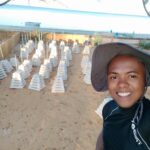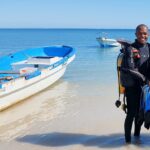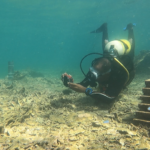Reef ecology is my focus and I am working towards a PhD as part of the ARMS Restore Project to restore the coral reef biodiversity in my country.
Similar to an underwater rainforest, coral reefs support 25% of all marine life in the world and over 500 million people worldwide for food and coastal protection. Healthy coral reefs support commercial and subsistence fisheries as well as jobs and businesses through tourism and recreation. Unfortunately, due to climate change and human activities, coral reefs around the world are threatened and coastal populations are becoming more vulnerable.
The Bay of Ranobe in southwest of Madagascar, where around 5000 fishermen are wholly depending on the marine environment for food, are becoming threatened by malnutrition due to declining fish catches, declining agriculture, and an increasing coastal population.
To address these issues, a new tool is being advanced by the Project Team: Autonomous Reef Monitoring Structures (ARMS) attached on the bottom to collect representatives of reef biodiversity. Deployed on healthy natural coral reefs, ARMS accumulated marine organisms that will be moved to artificial reefs after one year to jumpstart reef growth. Pivoting from the traditional PVC and stainless-steel design, we redesigned the ARMS using limestone because it is a natural substrate, is locally sourced, and the structures can be made locally through collaboration and employment of members of the community.
The effectiveness of limestone ARMS for collecting local reef biodiversity will be tested and quantified over the three years of the project, a large part of my PhD research. Six artificial reefs will be built inside the Bay of Ranobe and their biological impact will be measured and compared against natural coral reefs nearby. More specifically, the performance and benefits of seeding ARMS from healthy natural coral reefs onto three artificial reefs site will be compared to three artificial reefs without ARMS and three natural coral reef sites (without ARMS or an artificial reef).
Last year, 120 “seeding ARMS” were deployed on the most heathy reef in the Bay, where they will be left undisturbed for 12 months. Meanwhile, my team and I are conducting monthly surveys to study benthic succession on the ARMS plate in situ to describe the colonization and succession of benthic organisms on ARMS relative to the surrounding natural reef.
In January 2023, we plan to begin building the six artificial reefs inside the Bay of Ranobe. Ecological selection criteria have been developed by our team to help local communities identify locations that will yield the most benefit (e.g., fish biomass), based on my fieldwork and data collection to explore potential artificial reef sites in June 2022. Up next are community conversations to discuss the data and decide where to build the six 1-hectare artificial reefs.



